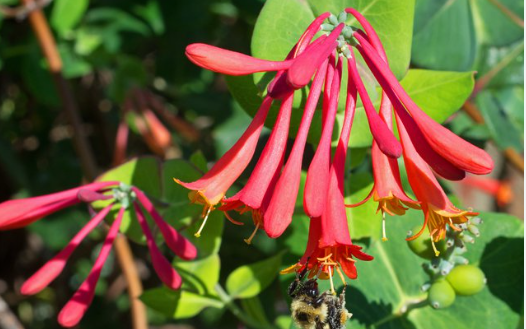
Honeysuckles are arching shrubs or twining vines in the genus Lonicera of the family Caprifoliaceae. It is a large genus with approximately 180 species. These plants have tubular flowers that bloom in colors of red, orange, pink, white, and yellow. They are native to North America, Asia, Japan, and Eurasia. Honeysuckles flourish in any ordinary garden soil, and a number are cultivated for their attractive flowers.
Honeysuckle plants can be evergreen or deciduous, with simple leaves arranged oppositely along the stems. The winter leaf buds have distinctive scales. Most species have two-lipped fragrant flowers with a sweet nectar. The tubular flowers are commonly borne in pairs. The fruit is a red, orange, or black berry that is attractive to wildlife.
Honeysuckle plants are generally hardy in USDA zones 4 to 9 and prefer well-drained loam soil with a pH range of 5.5 to 8.0. They can grow as vines reaching 10 to 25 feet in height or as shrubs that grow 15 to 25 feet tall and wide. Their bloom time is typically in spring and autumn.
The sweet nectar of honeysuckle flowers is attractive to pollinators like hummingbirds, butterflies, and bees. The berries produced by these plants are a food source for wildlife, including birds. However, berries of some species can be mildly poisonous to humans.
Major Species of Honeysuckle
- Lonicera periclymenum: Also known as the common honeysuckle, woodbine, or European honeysuckle, it is native to Europe, North Africa, Turkey, and the Caucasus. It is a vigorous, deciduous, twining climber with night-scented flowers.
- Lonicera japonica: This species, known as the Japanese honeysuckle, is native to eastern Asia. It is considered an invasive species in many areas due to its aggressive growth, which can cover and shade out other plants. It has fragrant, yellowish-white flowers and black berries.
- Lonicera hildebrandiana: Also called the giant Burmese honeysuckle, this species is native to China. It is a large evergreen vine with deep green leaves, 17-cm (7-inch) yellow flowers, and green berries.
- Lonicera sempervirens: Known as the trumpet honeysuckle, this species is native to the southeastern United States and is a twining vine with trumpet-shaped flowers that range from red to coral. It attracts hummingbirds.
- Lonicera etrusca: This species is native to the Mediterranean region and is known for its showy flowers, which bloom from early to mid-summer and continue well into mid-autumn.
- Lonicera pileata: Also called privet honeysuckle, this species is native to China, Korea, and Japan. It is a deciduous shrub that can reach a height of six feet and has ovate, bright green leaves.
Characteristics of Honeysuckle
Size and Growth Rate: Honeysuckle plants can grow as vines reaching 10 to 25 feet in height or as shrubs that grow 15 to 25 feet tall and wide. The growth rate can vary depending on the species and growing conditions, but most honeysuckles are considered fast-growing plants.
Growth Habit: Honeysuckle plants have a vining habit, with their stems twining around supports. They can also grow as shrubs. The growth habit can vary depending on the species.
Lifespan: The lifespan of a honeysuckle plant can be different with every species, but most species are long-lived and can survive for many years with proper care.
Leaves: Leaves are generally oval-shaped and can range in size from 1 to 3 inches in length. They are typically green, but some species may have variegated leaves.
Flowers: It produces tubular flowers that grow in clusters at the branch tips, in colors from pale pastels to rich reds. The flowers are highly fragrant and attract pollinators like hummingbirds, butterflies, and bees.
Root System: They have a fibrous root system that spreads horizontally. They are not considered invasive in terms of their root system, but some species can spread rapidly through their vines.
Light Tolerance: They are generally adaptable to a wide range of light conditions, from full sun to part shade. However, they tend to flower more profusely in full sun.
Water: Plants prefer moist, well-drained soil. They need regular watering, especially during the first year, to establish a strong root system. Once established, they can tolerate some drought but will perform best with regular watering.
Soil: Plants prefer well-drained loam soil with a pH range of 5.5 to 8.0. They can adapt to various soil types, including clay, sandy, and loamy soils.
Honeysuckle Problems
- Dying Honeysuckle: This problem is often due to drought or a lack of soil nutrients. The plant’s leaves may turn yellow and drop off, and the vines may die back. Lack of sunlight can also cause yellowing of leaves and leaf drop on the vines.
- Leaf Blight: Caused by the fungus Herpobasidium, leaf blight leads to deformed, thickened, and curled leaves, often with a whitish bloom. This can affect the plant’s appearance and health.
- Root Rot: Root rot is a fungal disease that affects the roots of honeysuckle plants. It is often caused by overwatering or poor drainage, leading to waterlogged soil conditions. Symptoms include stunted growth, yellowing or browning of leaves, and a foul odor coming from the roots.
- Powdery Mildew: This is a common disease that affects honeysuckle plants, characterized by the presence of a white, powdery substance on the leaves, stems, and flowers. It can cause curling or twisting of leaves, stunted growth, and yellowing of the foliage.
- Aphid Infestation: Aphids can cause significant damage to the plant’s foliage, leading to curled and distorted leaves, sticky residue on the foliage (known as honeydew), and the presence of ants on the plant.
- Spider Mite Infestation: Spider mites are tiny pests that thrive in dry and hot conditions. They produce fine webbing on the leaves and stems of honeysuckle plants, causing them to look dusty or dirty. Spider mite infestations can result in yellowing leaves, stippling or speckling on the foliage, and premature leaf drop.